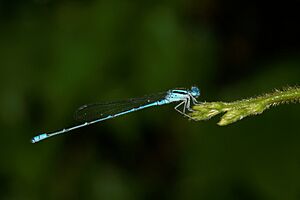Pseudagrion australasiae facts for kids
Quick facts for kids Pseudagrion australasiae |
|
|---|---|
 |
|
| Male | |
| Conservation status | |
| Scientific classification | |
| Genus: |
Pseudagrion
|
| Species: |
australasiae
|
| Synonyms | |
|
Pseudagrion bengalense Laidlaw, 1919 |
|
Pseudagrion australasiae is a type of damselfly. It belongs to the Coenagrionidae family. You can find this damselfly in countries like India, China, Indonesia, Malaysia, Myanmar, Singapore, and Thailand.
This damselfly is quite common. However, it is sometimes hard to spot because it looks very similar to other blue and black Pseudagrion damselflies.
Contents
About This Damselfly
What It Looks Like
This damselfly is a medium-sized insect. It has blue eyes that are dark on top. The back of its head is light blue with a black border.
Its main body, called the thorax, is a bright blue color. It has wide black stripes on its back and sides.
Its Abdomen (Body Segments)
The first two parts of its abdomen (segments 1 and 2) are blue. They have black marks on the top. The mark on segment 2 looks a bit like a vase. It is wider in the middle.
Segments 3 to 7 are black on top and blue on the sides. Each of these segments has thin blue rings at the end. Segments 8 and 9 are blue. They have a thin black edge at the end. Segment 10 has a large, X-shaped black mark on top. Its sides are blue.
Its Tail Parts
The upper tail parts, called superior anal appendages, are black. They spread out and then curve inwards like hooks at their tips. These parts are split at their ends. They are about half the length of segment 10. The lower tail parts are as long as the upper ones.
You can tell this damselfly apart from others like Pseudagrion microcephalum, Pseudagrion spencei, and Pseudagrion malabaricum. It has shorter tail parts. Also, its upper tail parts are split at the ends, which helps tell it apart from Pseudagrion malabaricum.
Female Damselflies
Female Pseudagrion australasiae damselflies have bluish-green eyes and thoraxes. Their markings are similar to the males. Their abdomen colors are like the males, but a bit lighter. Segments 8 and 9 are black with thin blue rings at the ends. Segment 10 is light blue.
Where It Lives
This damselfly likes to breed in different water places. You can find it in ponds, lakes, rice fields, and wet marshy areas.
See Also
- List of odonates of India
- List of odonata of Kerala





